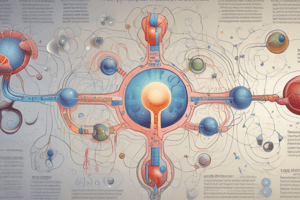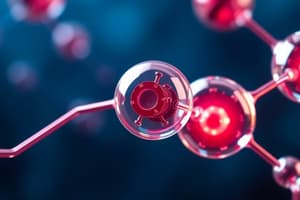Podcast
Questions and Answers
What is the primary function of hemoglobin?
What is the primary function of hemoglobin?
- Provides structural support for tissues
- Transports oxygen in the blood (correct)
- Inactivates toxins
- Carries cholesterol in the blood
Which protein is primarily known for providing structural support in hair and nails?
Which protein is primarily known for providing structural support in hair and nails?
- Keratin (correct)
- Globular proteins
- Antibodies
- Hemoglobin
What is the role of enzymes in biochemical reactions?
What is the role of enzymes in biochemical reactions?
- They transport nutrients
- They provide energy
- They catalyze reactions and increase their speed (correct)
- They serve as structural components
What is the function of immunoglobulins in the body?
What is the function of immunoglobulins in the body?
Nucleic acids primarily dictate which of the following?
Nucleic acids primarily dictate which of the following?
What is a significant role of salts in ionic form like potassium and sodium?
What is a significant role of salts in ionic form like potassium and sodium?
Why is water considered an excellent solvent?
Why is water considered an excellent solvent?
Which of the following properties does NOT apply to acids and bases?
Which of the following properties does NOT apply to acids and bases?
What do calcium salts contribute to in the human body?
What do calcium salts contribute to in the human body?
What role do buffers play in the body?
What role do buffers play in the body?
Which of the following best describes 'suspension' in a solution?
Which of the following best describes 'suspension' in a solution?
What is glucose predominantly known for in the body?
What is glucose predominantly known for in the body?
Which of the following is NOT a characteristic of electrolytes?
Which of the following is NOT a characteristic of electrolytes?
What is the role of aldosterone in the body?
What is the role of aldosterone in the body?
What percentage of organic matter in the body is accounted for by proteins?
What percentage of organic matter in the body is accounted for by proteins?
Which vitamin is involved in vision and found in orange pigmented vegetables?
Which vitamin is involved in vision and found in orange pigmented vegetables?
What function do amino acids serve in relation to proteins?
What function do amino acids serve in relation to proteins?
Which vitamin is known for promoting wound healing and is an antioxidant?
Which vitamin is known for promoting wound healing and is an antioxidant?
Which of the following is NOT a characteristic of glucocorticoid hormones?
Which of the following is NOT a characteristic of glucocorticoid hormones?
What are the primary elements found in proteins?
What are the primary elements found in proteins?
Which food sources are rich in Vitamin A?
Which food sources are rich in Vitamin A?
What does the term 'cephalad' refer to in anatomical terminology?
What does the term 'cephalad' refer to in anatomical terminology?
Which region of the body does 'sacral' refer to?
Which region of the body does 'sacral' refer to?
What does 'posterior' mean in anatomical terms?
What does 'posterior' mean in anatomical terms?
Where is the 'popliteal' area located?
Where is the 'popliteal' area located?
Which term indicates a structure located toward the midline of the body?
Which term indicates a structure located toward the midline of the body?
What does 'calcaneal' describe in body anatomy?
What does 'calcaneal' describe in body anatomy?
In anatomical terms, what does 'anterior' mean?
In anatomical terms, what does 'anterior' mean?
What area does 'nuchal' refer to?
What area does 'nuchal' refer to?
Which cavity contains the reproductive organs?
Which cavity contains the reproductive organs?
Which of the following organs is located in the right upper quadrant?
Which of the following organs is located in the right upper quadrant?
What is the main function of the spinal cavity?
What is the main function of the spinal cavity?
Which part of the body is contained within the dorsal body cavity?
Which part of the body is contained within the dorsal body cavity?
Which subdivision of the ventral body cavity is positioned inferiorly?
Which subdivision of the ventral body cavity is positioned inferiorly?
Which quadrant of the abdominal cavity contains the liver?
Which quadrant of the abdominal cavity contains the liver?
What structures are primarily contained in the thoracic cavity?
What structures are primarily contained in the thoracic cavity?
Which organ is NOT located in the abdominal cavity?
Which organ is NOT located in the abdominal cavity?
Flashcards
High Heat Capacity of Salts
High Heat Capacity of Salts
Salts in ionic form, like potassium and sodium, help regulate body temperature by absorbing and releasing heat. This prevents drastic temperature changes from external factors or internal activities like intense exercise.
Water's Polarity: Excellent Solvent
Water's Polarity: Excellent Solvent
Water's high polarity allows it to dissolve many substances, making it an excellent solvent essential for various biological processes.
Electrolytes & Electrical Conductivity
Electrolytes & Electrical Conductivity
Electrolytes, including salts, acids, and bases, conduct electricity when dissolved in water. This is crucial for nerve impulses and muscle contractions.
Importance of pH Balance in Cells
Importance of pH Balance in Cells
Signup and view all the flashcards
What is Biochemistry?
What is Biochemistry?
Signup and view all the flashcards
Glucose: Primary Energy Source
Glucose: Primary Energy Source
Signup and view all the flashcards
Hormones & Salt/Water Balance
Hormones & Salt/Water Balance
Signup and view all the flashcards
Proteins: Vital Organic Molecules
Proteins: Vital Organic Molecules
Signup and view all the flashcards
Amino Acid Composition
Amino Acid Composition
Signup and view all the flashcards
Hemoglobin: Oxygen Transport
Hemoglobin: Oxygen Transport
Signup and view all the flashcards
Keratin: Structural Protein
Keratin: Structural Protein
Signup and view all the flashcards
Functional Proteins & Enzymes
Functional Proteins & Enzymes
Signup and view all the flashcards
Nucleic Acids: Genetic Information
Nucleic Acids: Genetic Information
Signup and view all the flashcards
Nucleic Acids: Protein Structure & Cell Function
Nucleic Acids: Protein Structure & Cell Function
Signup and view all the flashcards
What are Anatomical Direction Terms?
What are Anatomical Direction Terms?
Signup and view all the flashcards
Inferior: Lower Body Part
Inferior: Lower Body Part
Signup and view all the flashcards
Anterior: Front of the Body
Anterior: Front of the Body
Signup and view all the flashcards
Posterior: Back of the Body
Posterior: Back of the Body
Signup and view all the flashcards
Medial: Towards Midline
Medial: Towards Midline
Signup and view all the flashcards
Dorsal Body Cavity
Dorsal Body Cavity
Signup and view all the flashcards
Cranial Cavity: Brain's Home
Cranial Cavity: Brain's Home
Signup and view all the flashcards
Spinal Cavity: Spinal Cord Protection
Spinal Cavity: Spinal Cord Protection
Signup and view all the flashcards
Ventral Body Cavity
Ventral Body Cavity
Signup and view all the flashcards
Thoracic Cavity: Heart & Lungs
Thoracic Cavity: Heart & Lungs
Signup and view all the flashcards
Abdominopelvic Cavity: Digestive, Reproductive, and Urinary Systems
Abdominopelvic Cavity: Digestive, Reproductive, and Urinary Systems
Signup and view all the flashcards
Abdominal Quadrants
Abdominal Quadrants
Signup and view all the flashcards
Right Upper Quadrant
Right Upper Quadrant
Signup and view all the flashcards
Left Upper Quadrant
Left Upper Quadrant
Signup and view all the flashcards
Study Notes
High Heat Capacity
- Salts in ionic form, like potassium and sodium, help absorb and release heat, stabilizing body temperature.
- This regulation prevents drastic temperature shifts from environmental factors and internal activities like vigorous muscle work.
- Calcium salts contribute to bone hardness and support structural integrity.
Polarity/Solvent Properties
- Water's high polarity makes it an excellent solvent, essential for biological processes.
- Electrolytes, including salts, acids, and bases, conduct electrical currents when dissolved in water.
- Living cells are sensitive to pH changes; acid-base balance is maintained by buffers, kidneys, and lungs.
Biochemistry
- Biochemistry studies chemical substances and processes in living organisms.
- Glucose is the primary energy source, with fructose and galactose converting to glucose for cellular use.
- Hormones like glucocorticoids and aldosterone help regulate bodily functions, including salt and water balance.
Proteins
- Proteins are vital organic molecules, constituting over half of the body's organic matter.
- Composed of amino acids, which contain carbon, oxygen, hydrogen, nitrogen, sulfur, and phosphorus.
- Example proteins include:
- Hemoglobin (oxygen transport in blood)
- Keratin (structural protein in hair and nails)
- Functional proteins, including enzymes, are crucial for biochemical reactions.
Nucleic Acids
- Nucleic acids, like DNA and RNA, contain genetic information essential for life.
- They dictate protein structure and influence cell functions.
Anatomical Terms
- Anatomical direction terms define body positioning:
- Inferior: lower part of the body (e.g., navel is inferior to breastbone).
- Anterior: front of the body (e.g., breastbone is anterior to spine).
- Posterior: back of the body (e.g., heart is posterior to breastbone).
- Medial: towards the midline (e.g., heart is medial to arms).
Body Cavities
- Dorsal Body Cavity:
- Cranial Cavity: contains the brain.
- Spinal Cavity: houses the spinal cord.
- Ventral Body Cavity: larger than dorsal, contains structures in the chest and abdomen.
- Superior Thoracic Cavity: includes heart and lungs.
- Inferior Abdominopelvic Cavity: houses digestive, reproductive, and urinary organs.
Abdominal Quadrants
- Medical personnel divide the abdominal cavity into four quadrants for examination:
- Right Upper Quadrant: liver, stomach, gallbladder.
- Left Upper Quadrant: liver, left adrenal gland, stomach.
Studying That Suits You
Use AI to generate personalized quizzes and flashcards to suit your learning preferences.
Description
Test your knowledge on the biochemistry concepts related to body temperature regulation, solvent properties of water, and the role of electrolytes and hormones in maintaining homeostasis. Understand the significance of salts, pH balance, and energy sources like glucose in living organisms.




